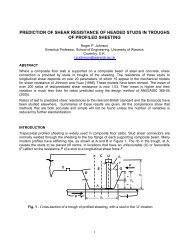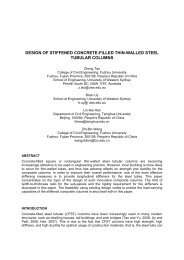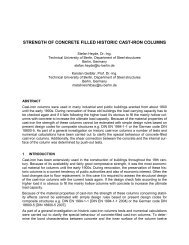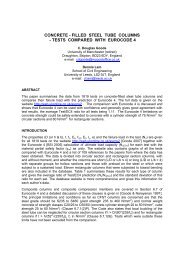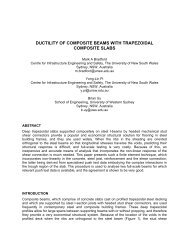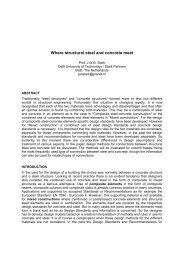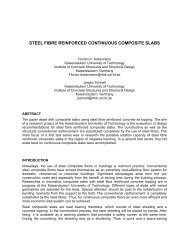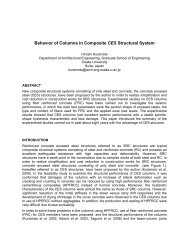developing composite action in existing non-composite steel girder ...
developing composite action in existing non-composite steel girder ...
developing composite action in existing non-composite steel girder ...
Create successful ePaper yourself
Turn your PDF publications into a flip-book with our unique Google optimized e-Paper software.
capacity <strong>in</strong> its overall load-deformation response due to the higher slip capacity of thisconnector. It is believed that high slip capacity of the HTFGB connectors enabled the shearconnectors at the <strong>steel</strong>-concrete <strong>in</strong>terface to redistribute <strong>in</strong>terface shear among the connectors.However, the HTFGB connectors are more difficult and time-consum<strong>in</strong>g to <strong>in</strong>stall than theHASAA and DBLNB connectors. Because of the easier <strong>in</strong>stallation characteristics of the HASAAand DBLNB connectors, an approach was developed to <strong>in</strong>crease the deformation capacity ofbeams retrofitted with these connectors.Oehlers and Sved (1995) <strong>in</strong>dicate that concentrat<strong>in</strong>g shear connectors near zero momentregions, result<strong>in</strong>g <strong>in</strong> the <strong>in</strong>crease of Ash<strong>in</strong> Eq. 2, can reduce slip at the <strong>steel</strong>-concrete <strong>in</strong>terfacewhen the beam reaches its full capacity. This suggests that simply supported beams with shearconnectors concentrated near the supports can likely show higher deformation capacity thanbeams with uniformly distributed shear connectors along the span.F<strong>in</strong>ite element analysis was used to evaluate the effect of mov<strong>in</strong>g shear connectors near thezero moment regions. First, the full-scale beam test specimens were modeled with ABAQUS.Figure 11 shows load-deflection relations for Specimen HASAA-30BS from the test along withthe f<strong>in</strong>ite element analysis results. As shown <strong>in</strong> the analysis result of Specimen HASAA-30BS,the model used <strong>in</strong> this research could not simulate the behavior after shear connector failure.However, the model is considered useful for predict<strong>in</strong>g the behavior before shear connectorfailure and the failure of the shear connectors. Figure 12 shows the longitud<strong>in</strong>al stressdistribution of Specimens HASAA-30BS from the FE analysis. As shown <strong>in</strong> the figure, neutralaxis of the beam moved toward the beam top flange due to <strong>composite</strong> <strong>action</strong> between the twostructural components.Figure 11 also shows the analysis results of a partially <strong>composite</strong> beam with shear connectorsconcentrated near the supports. In the FE model, shear connectors were moved near thesupports and were located at a 300-mm spac<strong>in</strong>g. The total number of shear connectors was notchanged <strong>in</strong> the model. The analysis model with concentrated shear connectors was same withthe analysis model of Specimen HASAA-30BS except the shear connector locations. ForSpecimen HASAA-30BS, the connectors were uniformly distributed along the length of thebeam, at a spac<strong>in</strong>g of 725 mm. Compared to Specimen HASAA-30BS, the deformation capacityof the partially <strong>composite</strong> beam with shear connectors relocated near the supports was<strong>in</strong>creased significantly. The <strong>in</strong>crease of its deformation capacity can be attributed to thedecrease <strong>in</strong> slip at the <strong>steel</strong>-concrete <strong>in</strong>terface as shown <strong>in</strong> Fig. 13. The partially <strong>composite</strong>specimen with concentrated shear connectors near the support shows much less slip than thespecimen with uniformly distributed shear connectors <strong>in</strong> ABAQUS.Load (kN)120010008006004002000HASAA-30BS (Test)HASAA-30BS (ABAQUS)Specimen with 300mmconnector spac<strong>in</strong>g (ABAQUS)0 50 100 150 200 250 300Deflection (mm)Figure 11 – Test vs. FE Analysis resultsFigure 12 – Longitud<strong>in</strong>al stressdistribution of a <strong>composite</strong> beam




